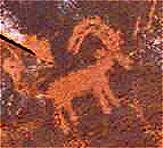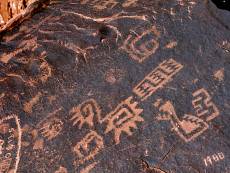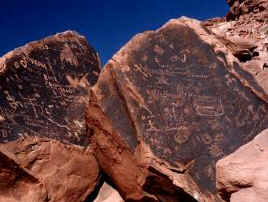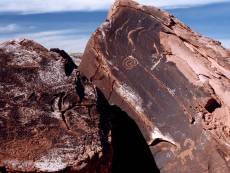 |
Lost Canyon at Moenave |
 |
Lost Canyon at Moenave |
Trading Post Ruins atMoenave |
In 1873 John D. Lee established a small farm 60 miles south of his ferry crossing at a spring called Moenave by the nearby Hopi Indians. In the years to follow he would hide out there from Federal Troops looking to arrest him for his alleged involvement in the infamous Mountain Meadow Massacre. In 1874 Mormon Troops camped here during the Mormon-Navajo unrest because of the dependable water from the spring. This water source also made Moenave a favorite stopping place along the Morman Honeymoon Trail. The names of the people who passed through here can be found pecked into the rocks behind the old trading post ruins near the spring. But these early pioneers weren't the first ones to camp here. This spring was a favorite of the ancient ones also. |
 |
 |
 |
Indian PetroglyphsThroughout the boulder strewn entrance to Moenave spring and its small canyon are the evidences of the ancient Native Americans who passed this way thousands of years ago. Buried beneath the sands of this haunted area can be found the remains of their camps and villages. I'm sure their ancient rock art inspired the pioneers who followed to inscribe their names here too. In fact, in some instances the names of the pioneers are etched over the petroglyphs as in the middle picture above. If that was done today we would call it vandalism. |
||
Mormon Battalion and PioneersIn 1874 the Navajo Indians fearing the Mormon settlement of their lands went on the warpath to expel these settlers. During this time of the Mormon-Navajo unrest both sides were getting ready for a fight. A Mormon Fort was built at Lee's Ferry, and the Mormon soldiers made camp at Moenave spring. Through delicate negotiations Jacob Hamblin the famous Mormon Mountain Man was able to avert the war and peace returned to the area. Many inscriptions of these Mormon soldiers and the pioneers who followed can be found in the rock walls on both sides of the canyon. This was also a camp site on the old Mormon Honeymoon Trail, where devoted Mormons made their way to and from Salt Lake City to be married in the Mormon Temple. |
||
|
|
|
© Copyright 2001 GRandall Web Design Service